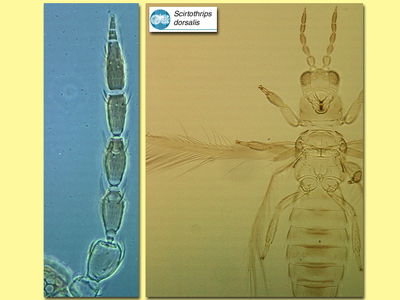Figures
Fig. 1 Antenna, head, thorax, abdomen, fore and hind wing
Fig. 2 Head (dorsal) and pronotum
Fig. 3 Fore and hind wings
Fig. 4 Meso- and metanotum
Fig. 5 Sternite VI and VII
Fig. 6 Tergite VII and VIII
Species
Scirtothrips dorsalis Hood
Biology
A highly polyphagous species, breeding on the young leaves of many unrelated herbs and shrubs, including chillies, tea and strawberries.
Distribution
Widespread from India to Japan and Australia.
Recognition
Small pale thrips with weakly shaded forewings and antennae; tergites and sternites each with antecostal ridge dark and a dark area medially. Antennae 8-segmented, sense cones on III & IV forked and stout. Head with one pair of setae in front of fore ocellus, and one pair between the posterior ocelli; ocellar region with a few transverse striae. Pronotum with many transverse striae, one pair of major posteromarginal setae. Metanotal sculptured striae forming a complex Y-shape, sub-parallel on posterior half but converging posteriorly and forming elongate reticles, transverse close to anterior margin; median setae not close to anterior margin. Forewing first vein with 3 setae on distal half, second vein with 3 widely spaced setae; posteromarginal cilia straight. Abdominal tergites with closely spaced rows of microtrichia on lateral thirds; median setae small and close together; tergite VIII with complete posteromarginal comb of microtrichia. Posterior half of each sternite covered with microtrichia, but anterior half without microtrichia. Male tergite IX without lateral drepanae.
Related species
At least 60 species are known in this genus worldwide, mainly from tropical countries, and in Australia there are several more species as yet undescribed.<







